
Saint Thomas Church is an Episcopal parish church of the Episcopal Diocese of New York at 53rd Street and Fifth Avenue in Midtown Manhattan, New York City. Also known as Saint Thomas Church Fifth Avenue or Saint Thomas Church in the City of New York, it was incorporated on January 9, 1824. The current structure, the congregation’s fourth church, was designed by the architects Ralph Adams Cram and Bertram Grosvenor Goodhue in the French High Gothic Revival style and completed in 1914.
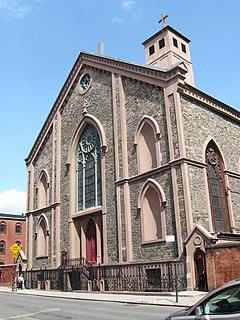
The Basilica of Saint Patrick's Old Cathedral, sometimes shortened to St. Patrick's Old Cathedral or simply Old St. Patrick's, is a Catholic parish church, basilica, and the former cathedral of the Archdiocese of New York, located in the Nolita neighborhood of Lower Manhattan, New York City. Built between 1809 and 1815 and designed by Joseph-François Mangin in the Gothic Revival style, it was the seat of the archdiocese until the current St. Patrick's Cathedral in Midtown Manhattan opened in 1879. Liturgies are celebrated in English, Spanish, and Chinese. The church is at 260–264 Mulberry Street between Prince and Houston Streets, with the primary entrance on Mott Street. Old St. Patrick parish merged with Most Precious Blood parish, and the two churches share priests and administrative staff.

The Minor Basilica of Saint Mary of the Immaculate Conception is a Black Catholic parish in downtown Norfolk, Virginia. It is the oldest parish in the Diocese of Richmond and is known locally as "The Mother Church of Tidewater Virginia".

Saint Joseph Cathedral, is located at 50 Franklin Street, in downtown Buffalo, New York and is currently the cathedral church of the Roman Catholic Diocese of Buffalo.
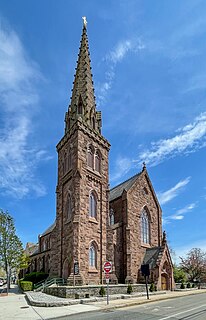
Patrick Charles Keely was an Irish-American architect based in Brooklyn, New York, and Providence, Rhode Island. He was a prolific designer of nearly 600 churches and hundreds of other institutional buildings for the Roman Catholic Church or Roman Catholic patrons in the eastern United States and Canada, particularly in New York City, Boston and Chicago in the later half of the 19th century. He designed every 19th-century Catholic cathedral in New England. Several other church and institutional architects began their careers in his firm.

St. Florian Church is a Roman Catholic Church at 2626 Poland Street in Hamtramck, Michigan. The church was designed by Ralph Adams Cram of the firm Cram and Ferguson.

The Cathedral of the Holy Cross is the cathedral of the Roman Catholic Archdiocese of Boston and is the largest Roman Catholic church in New England.

St. Patrick's Church is a Catholic church and parish in the Archdiocese of New Orleans, Louisiana, United States. The parish was founded in 1833, and the current structure was completed in 1840. It is the second-oldest parish in New Orleans, located upriver from the French Quarter at 724 Camp Street in what is now the Central Business District. The building, a National Historic Landmark, is one of the nation's earliest and finest examples of Gothic Revival architecture.
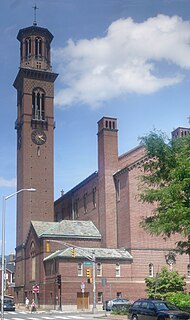
St. Paul Church is a parish of the Roman Catholic Church located at 29 Mount Auburn Street near Harvard Square in Cambridge, Massachusetts, in the Archdiocese of Boston. As well as serving as the local parish church, it is the home of St. Paul's Choir School whose students serve as the choristers in the Choir of St. Paul's, and the Harvard Catholic Center serving the academic community of Harvard University.

St. Peter the Apostle Church was a Roman Catholic church located within the Archdiocese of Baltimore in Baltimore, Maryland. Constructed at the northwest corner of Hollins and South Poppleton Streets and, it was often referred to as "The Mother Church of West Baltimore."

The Basilica of Saints Peter and Paul in Lewiston, Maine, also known as Ss. Peter and Paul Church, is a church which is a part of the Roman Catholic Diocese of Portland.
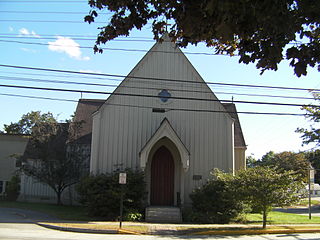
St. Paul's Episcopal Church is a historic church at 27 Pleasant Street in Brunswick, Maine. Built in 1845, it is a distinctive early example of a modest Carpenter Gothic design by Richard Upjohn, then already well known for his larger-scale Gothic churches. The building was listed on the National Register of Historic Places in 1978. The rector is Rev. Carolyn H. Eklund.
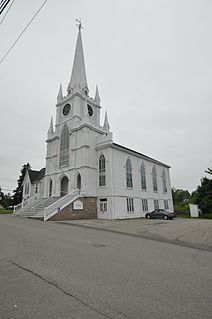
Centre Street Congregational Church is a historic church at 9 Center Street in Machias, Maine. Built in 1836-37, it is an important early example of Gothic Revival architecture in northern New England, apparently based on an early design by the noted Gothic architect Richard Upjohn. The building was listed on the National Register of Historic Places in 1975. The congregation is affiliated with the United Church of Christ; its current pastor is Rev. Susan Maxwell, M. Div.

St. Patrick's Catholic Church is a historic church at 380 Academy Hill Road in Newcastle, Maine. Built in 1807, it is the oldest surviving Roman Catholic church building in New England, and was listed on the National Register of Historic Places in 1973. It remains in use as a community within the Parish of All Saints in the Diocese of Portland.

The Church of St. Paul the Apostle is a Catholic church on the Upper West Side of Manhattan in New York City. It is the mother church of the Paulist Fathers, the first order of Catholic priests founded in the United States

St. Paul's Episcopal Cathedral, is located in downtown Des Moines, Iowa, United States. It is the cathedral church of the Episcopal Diocese of Iowa. The building was listed on the National Register of Historic Places as St. Paul's Episcopal Church.

The Church of All Saints is a historic former Catholic church in the Archdiocese of New York, located at 47 East 129th Street, at the corner of Madison Avenue in the Harlem neighborhood of Manhattan, New York City.

The Church of St. John the Evangelist is a parish of the Roman Catholic Church in the City of Orange Township, Essex County, New Jersey, within the Archdiocese of Newark. It is noted for its Gothic Revival style church (building), a prominent local landmark located at 94 Ridge Street.

St. Paul's Catholic Church is an historic church building located in Burlington, Iowa, United States. Together with the Church of St. John the Baptist in Burlington and St Mary's Church in West Burlington it forms Divine Mercy parish, which is a part of the Diocese of Davenport. The parish maintains the former parish church buildings as worship sites. St. Paul's Church and the rectory are contributing properties in the Heritage Hill Historic District listed on the National Register of Historic Places. St. Paul's School was also a contributing property in the historic district, but it has subsequently been torn down.

St. Andre's Parish is a former parish of the Roman Catholic Diocese of Portland, located on Bacon and Sullivan Streets in Biddeford, Maine, USA. The parish was founded in 1860 to serve the city's large French-Canadian and French-American communities. On July 1, 2008, St. Andres was merged into the newly formed Good Shepherd Parish. The parish complex of four buildings, including the church, rectory, convent and school, was listed on the National Register of Historic Places in 2015, at which time most of it stood vacant.






















